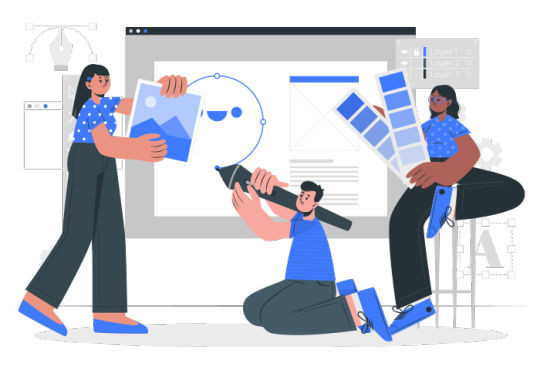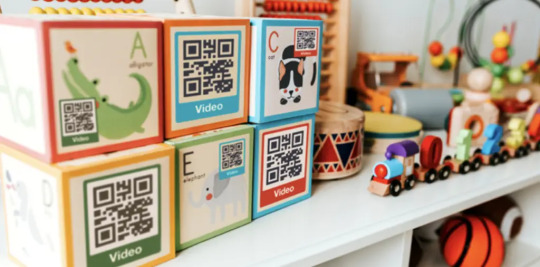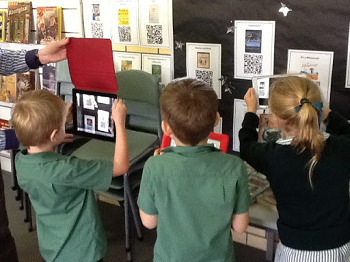Don't wanna be here? Send us removal request.
Text
PDF QR Codes in the Education Sector

In the modern digital world, realizing technology's educational potential is crucial. With the introduction of QR codes, educators have discovered a potent tool to improve educational experiences. What if, however, we told you that there is a method for using QR codes in education that is much more effective? PDF QR codes are a dynamic fusion of practicality and adaptability that has the potential to transform how students interact with and learn from instructional content. In this article, we'll look at how PDF QR codes are reshaping the educational landscape and explain why every educator needs to be aware of them. Let's begin straight away!
What are PDF QR codes?
Combining the efficient tools of PDF files and QR codes creates PDF QR codes. PDF files preserve layout and formatting digitally, regardless of the hardware or application used to view them.
What occurs when these two technologies are combined, though? You receive a PDF QR code, a unique graphic resembling a barcode, and a link to open or download a particular PDF file. Users can quickly access educational content in PDFs by scanning this code with any smartphone or tablet with a QR code scanner app.
Easy access
There are many benefits of using PDF QR codes in teaching. They offer quick and straightforward access to various educational resources, including textbooks, worksheets, study aids, and more. Students can now scan the code to access their compulsory reading materials, eliminating the need to lug around bulky backpacks full of real books.

Multimedia and data sharing
Educators can enhance student engagement by integrating interactive components like resource links, concept-explaining videos, quizzes, and more into their PDF files. The incorporation of multimedia encourages students' active participation and improves comprehension.
Integrating PDF QR codes in education opens up possibilities for educators and students.
How can PDF QR codes be used in education?
Education is no exception to the growing popularity of QR codes across numerous sectors. Using PDF QR codes is a novel technique to improve student learning and give teachers access to valuable materials.
Extra materials
Teachers can create QR codes that link to supplementary content in PDFs, such as additional readings, films, or interactive exercises related to the topic. This enables students to explore different perspectives and delve deeper into the subject matter at their own pace.

Assessment
The use of PDF QR codes in education for testing is another example. Teachers can generate a QR code directly linking to a quiz or assessment as a PDF document. Students can complete the assessment digitally by scanning the code with their cellphones or tablets. This eliminates paper waste while also saving time.
Notices and announcements
An effective tool for delivering information is a PDF QR code. To disseminate vital notifications, event information, or even admission applications, schools can utilize them on posters or flyers. Parents and children can instantly access all pertinent information without having to sift through mountains of documentation by scanning the code.
Progress reports
To manage classrooms effectively, teachers can assign each student a unique QR code that leads to their individual behavior chart, which they can prepare as PDF files. This approach allows teachers to track student development and motivate all individuals easily.

Versatile technologies like PDF QR codes have a lot of promise to change how education is done. These tiny black-and-white squares contain enormous significance in improving teaching and learning experiences. It can provide supplemental materials, facilitate exams, help with effective information exchange, or classroom management!
The benefits of using PDF QR codes in education
The educational industry can profit significantly from PDF QR codes. There are many uses, but it has an equally high number of benefits.
Quick distribution of materials
They offer a practical method for exchanging and distributing digital materials, including textbooks, study aids, and lecture notes. Students can quickly access the PDF content by scanning the code with their cellphones or tablets.
Participatory learning
PDF QR codes encourage participatory learning. Teachers might design QR codes that point to multimedia resources like films or interactive quizzes to increase student engagement and comprehension. This makes it possible for students to engage in their learning in an active, more dynamic learning environment in the classroom.

Cheap and accessible
Schools can save money on printing costs by converting textbooks and handouts into PDF files and making them accessible through QR codes. Additionally, eliminating the need for physical storage space is possible when all resources are stored digitally.
Nurtures effective communication
PDF QR codes allow teachers and parents/guardians to communicate effectively. Report cards and parent-teacher conferences are also appropriate for issuing QR codes leading to newsletters or significant announcements.
Convenience, engagement, cost savings, and increased communication are all benefits of using PDF QR codes in education for instructors and students.

How to create a PDF QR code
Creating a PDF QR code is a simple process that can be done in just a few steps. You can create a QR code with the necessary information and equipment in just a few easy steps. Here's how you can do it:
1. Pick a QR code generator: Numerous web platforms offer services for producing QR codes. Look for one that converts PDF files right into QR codes. You should also look at the auxiliary benefits given by the website.
2. Upload the PDF: Your desired file to generate a QR code should be uploaded. After selecting a suitable generator, upload the PDF document. Ensure the file contains essential information or study materials for your class. Don't worry if the file is wrong; you can change it without reprinting the QR code with a dynamic QR code.
3. Change the design: You can modify a few generators to display different colors or logos in your QR code. This is an excellent opportunity to include and aesthetically accentuate different designs that appeal to the students more.
For example, You can add your class/school mascot, or for report card PDF QR codes, you can add the student's favorite animal.
4. Generate and test: Customize your QR code and click "Save" to view the output. Then, perform functional testing on multiple scanners and devices to ensure they work correctly.
5. Use effectively: Once you produce your custom QR code, add it to easily viewed and accessible places such as notice boards, classrooms, or benches.
Always remember to monitor its performance using analytics tools so that you can determine its use by students and make any necessary modifications.
Conclusion
Education changes quickly, and teachers always seek new, creative methods to improve learning experiences. In education, PDF QR codes have become a helpful tool that offers a quick and engaging way to exchange information with pupils.
Teachers may give students access to extra resources, workbooks, study guides, and even quizzes using PDF QR codes in the classroom. Students can quickly access these resources by scanning the code with their cellphones or tablets. This saves time and guarantees that students have access to all relevant materials.
There are many advantages of employing PDF QR codes in teaching. Integrating technology into the teaching and learning process increases student involvement. Students can take an active role in their learning process by scanning QR codes and getting online access to pertinent content.
0 notes
Text
How to Select the Right Digital Business Card Platform?

Are you tired of carrying around all the business cards in your pockets? Or rather frequently run out of them at events and have them lost? That is a problem you won't have with Digital Business Cards. You get to say goodbye to those conventional paper options with QR code digital business cards.
But how do you pick the right option? How do you decide what features to look for in it? We have it all covered in this blog, from data security to customization.
Before proceeding, if you need the list of top digital business cards, check here.
So, let’s understand the nuances of a digital business card!
Customizable designs

Getting your QR code business card is a crucial next step for your business. You should be able to customize your digital business card as much as possible. Everyone you deliver a digital business card to has a lasting impression. It needs to convey your message, personality, and brand.
You may access various design options on a reliable digital business card platform, such as templates, color schemes, and font styles. This adaptability enables you to create a unique, eye-catching card that goes well with your logo.
You can personalize the entire landing page and include your information with digital business cards. You can add multimedia features and photographs for all users to see in addition to contact information.
Trackable analytics

An important component of a digital business card is the tracking and analytics support. You can get critical data on your networking practices and campaigns. You can use these trackable analytics to improve your campaign strategy in the future. It proves to be a valuable resource for networking and communication.
You can determine which contacts use your digital business cards the most by keeping track of information like views, clicks, and downloads. This data can be used to locate prospective leads or clients who have genuinely expressed interest in your products or services.
With tracking and analytics, you can calculate the effectiveness of different designs and components of your QR code business cards. This is a goldmine of data that can't be looked over today. You can test different content or layout alternatives and track how engagement rates change.
White labeling

White labeling is a familiar concept for people and a necessity for businesses. So, if you own a business or a brand with white labeling, you can add that touch to your QR code business cards, too. You can change the design components on your digital business card to reflect your brand.
By white labeling your digital business card, you can avoid the unfortunate association with other people or retailers or any misunderstanding. This strengthens the audience's association with the brand and increases their trust in it.
Bulk uploads

Bulk uploads are important for any digital business card platform. It saves both time and effort while uploading large numbers of contact details to make a QR code digital business card. Companies and corporations looking to create a large number of cards should specifically consider this.
Your contact information can be quickly arranged in a spreadsheet or CSV file and uploaded in bulk to the platform. By doing this, you can avoid manually entering data and ensure its accuracy and coherence among your contacts.
Bulk uploads make it simple to add new contacts, enabling you to grow your digital business card database swiftly. Whether you are in charge of a small staff or a large sales force, this function is essential for efficient contact management.
Folders and subaccounts

Once a digital business card is created, managing it becomes crucial. Having the choice of folders and subaccounts makes the whole process easier. You can easily catalog the contents into different criteria, such as clients, colleagues, and projects. This streamlines the different channels of your networking process. Subaccounts are also helpful if several team members require access to specific contacts or groups of contacts.
You can also create special criteria if you select the correct QR code business card platform. You can organize your contacts any way you see fit with this functionality, whether you want to group them by industry or location.
Within the platform, you can set permissions and manage who sees what. As everyone is on the same page, this promotes collaboration and efficiency.
Encryption

Encryption dramatically improves the security and privacy of digital business cards. Using complex algorithms, data is converted into an unintelligible format, making it nearly impossible for unauthorized users to access or comprehend the information.
By combining encryption technologies, digital business card systems assure consumers that their sensitive data is secure. Encryption ensures that only those with the proper authority may decode and access the data, whether it be contact information, corporate data, or any other sensitive information.
Thanks to robust encryption methods, businesses can confidently distribute their digital business cards without worrying about potential data breaches or unwanted access. This ensures the privacy of their contacts and clients receiving their digital communications and personal information.
Data security

Data security is a crucial aspect to consider when selecting a digital business card platform. Due to the increasing risk of data breaches and cyberattacks, your sensitive information's security must be prioritized when choosing a platform.
A trustworthy digital business card platform should protect your data using cutting-edge encryption. By doing this, you can be sure that only authorized users can view and use your digital cards. Through encryption, data is rendered unreadable to unauthorized persons, enhancing security.
Look for platforms that have backup and disaster recovery capabilities together with encryption. These precautions guarantee that your data will remain secure and reachable even during an unplanned event or a technological malfunction.
One essential aspect to consider is the level of control you have over your data. Choose a platform that lets you alter people's access levels and permissions within your company. This reduces the possibility that third parties will unintentionally share or access private information.
Backup and disaster recovery

Backup and disaster recovery should always be considered when selecting a digital business card platform. In the ever-evolving digital landscape, a backup solution is essential to ensuring your data is always protected.
Regular data backups should be provided by a dependable digital business card platform so that any incorrect or missing data may be quickly replaced. This guarantees that your crucial contacts and data won't be lost forever, even in a catastrophe like hardware failure or an unintentional deletion.
The platform provider also needs to execute a disaster recovery plan successfully. This shows that they have mechanisms to quickly restore their services in case of any unplanned delays or disruptions. Your firm will benefit from less downtime and simple access to your digital business cards.
Conclusion
Any modern professional or entrepreneur must have a polished and attractive digital business card in today's digital world. You can quickly develop and manage your virtual business cards with the correct platform, making sure that you leave a positive impression on potential customers and coworkers.
In conclusion, digital business cards have transformed networking by giving professionals a productive means to contact people in today's fast-paced world. You may develop a memorable and effective digital business card with the correct platform.
0 notes
Text
How Are QR Codes Transforming Education?
Welcome to the digital era of education, where innovation is expanding education's frontiers like never before. One such technological marvel that has revolutionized schools worldwide is the QR code. These pixelated squares may have begun to appear everywhere, including on product packaging, advertisements, and even museum exhibitions.
Did you know, though, that QR codes are also altering how people learn? This blog post delves into the fascinating world of QR codes and examines how they change the way teachers and students learn. So fasten your seatbelts as we embark on an intriguing journey into a world where cutting-edge technology and traditional textbooks mix.
What are QR codes?
QR codes are two-dimensional barcodes that smartphones and tablets can scan. Since the 1990s, they rapidly gained popularity worldwide after Japan developed them first. These codes consist of a pattern of black squares on a white background containing encoded information.
You may access the particular data that each QR code carries by scanning it using a QR code reader app. This information may include text, URLs, phone numbers, and multimedia files such as photographs or movies. The system directs the user straight to the appropriate content without requiring manual input after scanning. QR in classrooms has many advantages in educational settings, including:
Versatility
Two key advantages of QR codes are their adaptability and ease of use. They facilitate the connection of physical and digital resources in educational settings. Textbooks can now feature QR codes and printed content to give students access to additional materials like interactive quizzes, illustrative movies, or further reading.
No geographical limitations
Additionally, QR codes remove geographical restrictions by allowing online materials to be accessed anytime and anywhere. By scanning a QR code their teacher provided, students can explore external websites or watch instructive films without relying on their textbooks.
Instructional tools
Moreover, adopting QR codes as teaching aids can benefit teachers. By incorporating various media kinds into these scripts and giving them to students for solo research projects or group assignments, they can build individualized learning experiences.
Engagement and interactivity
With its capacity to raise participation and interaction in educational settings while offering quick access to various educational resources - whether it be resolving maths issues through interactive lessons or discovering historical sites through virtual tours.

Source: https://www.soup.io/how-are-qr-codes-used-in-early-education
Teachers can foster a more participatory and engaging learning environment that accommodates a variety of learning styles by integrating QR codes into educational practices.
As technology develops, QR codes offer more opportunities for educators and students to utilize in education, creating an exciting time for them.
How are QR codes being used in education?
QR codes have developed into a potent tool that alters conventional teaching strategies and raises student involvement in education. Educators creatively utilize these compact barcodes to enhance interactive educational opportunities and give students more accessible access to digital content.
Material supplementation: Students can access supplementary materials like movies, websites, or quizzes linked to the current topic by scanning QR codes inserted in their textbooks rather than depending exclusively on static text. They have more profound knowledge as a result, and it also promotes self-directed learning.
Classroom management: Teachers can make QR codes for each student that carry data on their assignments, grades, or future activities. Teachers and parents can quickly stay organized and track crucial information by scanning these personalized codes with their smartphones or tablets.
Co-curricular learning: Historic sites and museums enhance their educational tours using QR codes. Scanning the codes near the artifacts or displays allows visiting students to quickly obtain detailed information or multimedia presentations about the objects they observe. All ages will find learning history to be more exciting and engaging thanks to this immersive experience.
Daily tasks and attendance: In tests and exams, students can access questions fast by scanning QR codes with code-scanning software on their mobile devices. Personalized QR code stickers are being applied to student ID cards by educational institutions to track attendance.
QR codes are transforming the delivery and accessibility of education, becoming an effective instrument. They are an invaluable addition to learning environments and classrooms because of their many advantages.

Source: https://www.tes.com/teaching-resource/maths-games-qr-codes-12475229
Why choose QR codes?
Accommodates different learning styles
Information may be accessed quickly and simply with QR codes. Students can quickly access resources like movies, articles, or interactive quizzes by scanning the code with their smartphones or tablets. This enables a more dynamic and exciting learning experience accommodating various learning preferences.
Independent learning
Students can quickly investigate topics of interest by giving them access to materials beyond what is provided in textbooks or lectures. This promotes curiosity and self-directed learning.
Enhances collaboration
Teachers can design group projects that assign each student a specific role connected to a distinct QR code that carries the necessary data or instructions. Students increase their mastery of the subject topic while developing cooperation skills by deciphering each other's codes and sharing information.
Supports inclusivity in education
It is possible to insert audio descriptions or translated text within the code for users with visual impairments or language hurdles. This guarantees all pupils equitable access to educational materials regardless of their needs.
Promotes feedback loops
Teachers can provide students with rapid feedback on their strengths and areas for improvement by linking assessment criteria or rubrics directly through QR codes on assignments or test sheets without having to write extensive comments.
Using QR codes in education has various advantages that improve teaching strategies by promoting accessibility, motivating self-directed learning, fostering cooperation, promoting diversity, and streamlining evaluation procedures. It's conceivable that educators will harness the power of QR codes in even more creative ways as technology develops to improve education further.

Source: https://twitter.com/Seesaw/status/967806661481107456
The challenges of using QR codes in education
QR codes have undoubtedly revolutionized how education is delivered. Still, like any technology, they come with their fair share of challenges.
Internet access: There are still places where connectivity could be improved or improved, even though many kids and schools now have reliable internet access. This could make it more challenging to incorporate QR codes effectively into teaching methods.
Access to smartphones: Despite the growing popularity of smartphones, not all students may have access to one or be permitted to use one while in class. This raises an equality concern because certain kids could not benefit from QR code activities.
Technical difficulties: Students may experience problems like hazy pictures or broken scanners, which could hinder their learning process and frustrate professors and students.
Privacy concerns: Teachers are responsible for maintaining the security and privacy of any personal data associated with a particular student's account. In case of breaches or security issues, it would reflect poorly on the teacher and the institute.
Integrating QR code: For educators who need to have more training to adopt this type of technology efficiently, it necessitates careful preparation and training.
Despite these obstacles, educators continue to develop creative solutions by offering alternate methods of information access that don't entirely rely on a smartphone or data connection.
We may anticipate additional advancements in tackling these issues as technology develops and becomes more widely available. This includes addressing the problems related to employing QR codes in education.
Case studies
Case study 1:
A project on plant identification was given to pupils in a high school biology class as an illustration. The teacher used QR codes rather than textbooks and lectures in the lesson plan. A set of plants with accompanying QR codes was distributed to each pupil. Students could access interactive information about each plant's traits, habitat, and uses by scanning these codes with smartphones or tablets. This practical technique not only enhanced learning but also promoted autonomous research abilities.

Source: https://mytechclassroom.com/qr-codes-in-the-classroom/
Case study 2:
Another compelling case study comes from a geography lesson in elementary school. For young students, the teacher intended to make map reading more participatory. As a result, she asked students to hold up QR codes that led to online materials like films, tests, and virtual tours focused on particular locales or global sites. While in class, students avidly scanned the codes. They collaborated to learn new facts about many nations without leaving their seats.

Source: https://teachingscience.us/qr-codes-in-the-classroom/
Case study 3:
A history teacher at a middle school included QR codes in a field trip to a QR museum. Students were given background material via QR code bookmarks before seeing an art show on ancient civilizations. They could use their smartphones to scan the matching QR codes in each display as they looked over the exhibit's numerous artifacts to get more details and historical background.

Source: https://qr-codes.com/qr-codes-as-graphic-art/
These real-world examples show how integrating QR codes into teaching techniques may boost participation and encourage active learning across various disciplines and grade levels.
How to use different QR codes for different age groups
QR codes have become a popular tool in education, providing an interactive and engaging way for students to access information. One of the significant advantages of using QR codes is their flexibility, allowing educators to customize them based on the age group they are teaching.
Younger students: You may easily access online materials or instructional games by using QR codes. QR codes that link directly to kid-friendly websites or apps that reinforce educational concepts can be made by teachers. This not only keeps young students interested but also aids in the early development of their technology abilities.
Middle school and high school: More sophisticated applications for QR codes exist. Professors can develop QR codes pointing to video lessons or supplemental information for students exploring a subject. Teachers can also use QR codes in interactive worksheets or scavenger hunts, where students must scan various codes to find information and solve puzzles.
College students: Since many students own smartphones or tablets, teachers might include QR code-based activities in their lectures and homework assignments. These can involve obtaining supplementary readings about the course material or scanning a code to verify attendance at the start of class.
Teachers can use QR codes most effectively in enriching student learning experiences by adapting their use to different age groups. These adaptable tools offer countless opportunities for involvement and interaction in the classroom, from primary schools to higher education institutions.
The future of QR codes in education
The potential for innovation and better learning experiences with QR codes in education is enormous. QR codes are anticipated to become more prevalent in classrooms worldwide as technology develops.
Interactive learning materials
Consider adding QR codes to textbooks so readers can scan them to access more information, movies, or even virtual reality experiences connected to the studied subject. This would improve learning and allow for the more individualized study of topics of interest to the pupils.
Remote learning
Students can access assignments, lecture notes, and other educational resources from anywhere, anytime, by scanning a code shown on their displays or transmitted via email or chat.
Moving forward, there is a lot of exciting potential for using QR codes in education, but issues must be resolved. Teachers will require training to effectively incorporate this technology into their lesson plans while maintaining accessibility for all students.
Conclusion
As we've seen, QR codes are dramatically changing schooling. They link the natural world and the digital one, giving students rapid and simple access to information. QR codes have developed into a priceless resource for educators thanks to their adaptability and simplicity of usage.
We anticipate much more incorporation of QR code technology in schooling.
As these technologies progress, more immersive learning experiences utilizing augmented reality (AR) and virtual reality (VR) alongside QR codes may become possible.
1 note
·
View note